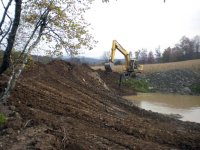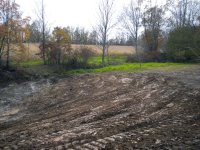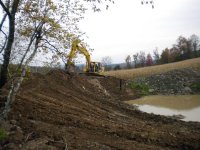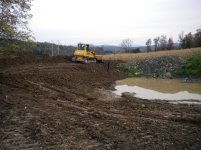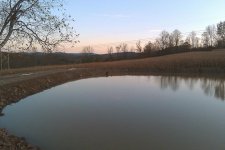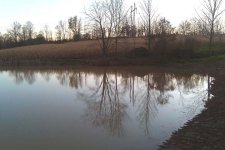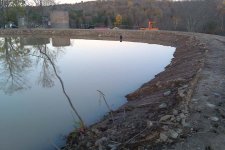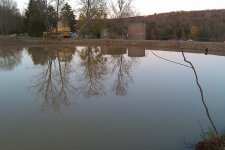it has been a few months since i last been on Tractorbynet. but there were some good threads. showing folks pulling trees out. using A frame and a chain.
an A frame would be set right up to a tree or near to it. then chain wrapped a couple times around tree or a tree / brush grabber placed around bottom of trunk. then chain ran up and over the A frame. and then chain extended to tractor.
the above setup. allows much more force to be applied in pulling the tree straight up and out of the ground. vs trying to pull a tree over onto its side were power is lost.
this also allows you to place enough chain between tree and you. so tree does not come down on your head. and it does not mean you need to get ladder out to place chain high up on a tree. to try and pull it over.
=========================
as far as tractor in pond, i am also skiddish. around here on this farm. if it means mud, it normally means = stay away! or be stuck.
i created a thread a while back about dredging a pond. and what shined the most was a "tracked excavator" and wooden pallets it used along with some logs it used.
YouTube - Broadcast Yourself. has some good videos. were they took some ties 6" x 6" and bolted them all together so they could create a pad that they could push between the tracks of the excavator. ((width)) and then they extended a few feet ((long)) past each side of the tracks when turned 90 degrees.
the excavator had a hydraulic thumb on it as well. so they could go a couple feet spin 180 pickup a wood pad. spin 180 drop it in place and nudge it were the wanted it. move a couple feet onto it. then repeat as needed as they dug the area out.
==============
a TLB (tractor loader backhoe) just can not do the 360 degree spin like an excavator can. which means getting the wood pads very difficult. plus TLB = constantly raising lowering the out riggers. unlike an excavator.
the only other option that i found that might be worth it atleast for me. is paying a "dredging" company to come out and clean one of the lake/pond out. to steep of hills around majorty of the sides. they make kinda like a pontoon boot. with a rock mud silt handling pump on it. that acts like a vacuum to suck the silt out. but for me, while this would work in a good amount of area and might be in budget to buy a second hand unit from someone else. the dredges that have tiller head on them. would be perfect for me, though the tilling head units cost way way way to much. resulting in excavators being next best thing for over all cash spent and what could get done. and over all result of everything.
===================
as far as renting a unit and DIY or paying operator. myself i would prolly choose renting and DIY, it may take me longer to get what i want, but i would most likely get a few other small projects done to my liking. someone else, not operator inclined when running machinery, may be much better off paying for a good excavator operator. to get it done faster and have it done with less hassle or head aches. and a good operator would more likely be able to know how to get angles of dirt here and there, so "wash outs" etc.. later down road would be down the very min if at all.
======================
one last note. if the pond has a dam holding the water in the pond. it might be worth just breaking the dam open. and letting the entire area set for 2 to 3 years to let the soil drain of water. then get in there with a regular tractor if that is how you want to do it. and then once cleaned up re build dam. and re do clay lining if need be.
======================
one other option to above. i have built a 4" pipe siphon over 2 pond dams here on the farm.
i took a 5 gallon bucket, drilled 1/2" holes all around the sides and bottom. ((acts like a grate to keep your fish in your pond)) took a 4" cheap toliet flange. and drill hole in lid of 5 gallon bucket.
i took some ""nylon rope"" and concrete blocks. and wrapped around the bucket and pipe coming off of bucket. ((so pipe and bucket do not float on surface of water)) and extended the bucket out a good 40 feet.
i used cheap 4" knife valves ((local hardware supply store not lows or home deport,, or more likely buy over internet)) one valve was located up on dry land. between bucket and before the 45 going up and over dam. the other valve located as far down as i could on the dry side of the dam.
on the very top of this 4" pipe on top of the dam. i placed a 4x4x4 tee. then in the top of the tee i reduce down to a 2" pipe. then a 2" ball valve.
i bought a 12v cigeretee lighter 110v convertor (best buy, radio shack, etc... normal marked for a computer plug in). and then a very cheap submersable sump pump. it only pumps say 5 gallons per hour at 5 feet of head. this was not about how much Gallons per hour it could pump. but rather, would my s10 blazer and convert be able to handle the amps and power, so buying smaller pump had to be the choice. it is slow. going. but i also got a heavy duty long extension cord (not a cheap thin small extension cord) to run between convert and pump. the cord was expensive. but noticeable difference.
the above allowed me, to just drive the blazer down to the area. plug in the convert and extension cord and pump. run a garden hose up to the tee. and start filling the pipes up with water. vs dragging couple hundered plus pond generator down. deal with even a heavier pump that was even harder to swing toss out into the water.
the one thing to above. was i used a 2 littler soda bottle wedge between brake peddle and gas peddle to set my blazer RPMs a little higher than idle. i could not get a stick wedge on gas peddle and seat just right. and the 2 little soda bottle just apply the very small little bit of pressure. to get a couple more RPM's to keep the juice going that was needed to drive the pump.
((WARNING)) keep vehicle running, or you may not be able to start it back up.
ok, you got a 5 gallon bucket cage to keep fish in your pond with some concrete blocks on the end to keep the end of pipe below water level
you have 4" pipe up to dry land, with a knife valve, then 45 to top of dam, then a tee, with a 2" ball valve on top. then another 45 going down the dry side of dam. then as far as you can go another 4" knife valve.
you also have converter, heavy duty extension cord, and a small cheap submerable pump and some garden hose.
close the two 4" knife valves fill pipe up with water. close 2" ball valve (making sure water from the pump is spilling out of it) open the 4" valve nearest pond, then open valve clear down on dry side of dam.
give it a day or 3 and your pond will be drained down to within a couple inches of top of 5 gallon bucket.
pending on how well your glue joints are and hopefully you used the longer (couplings) between pipes to get a better tight fit. that will not come loose. you may need to shut the 2 4" knife valves once a day, and refill the pipe up from submersible once a day if that. ((water can move fast enough, and turbulent enough, that it can pull air directly out of the water, causing upper section of pipe to fill with air and stop the siphoning of water or cause the GPH it pumps to be drastically reduced))
it beats having to break the dam open, granted you need to check daily during inital draining, and then redo after a rain. but it might help you keep the lake level down far enough through out a year or 2. to allow enough things to dry out enough to get in there with a regular tractor.
you could also get a gas powered water pump. but you need to constantly fill the gas tank up on them and worry about running the pump dry (no water being pumped. and still need to pay for the piping. the siphon works. great. the only draw back, is the pipe end on the dry side of the dam. needs to extend below the water level of pond that you want to drain down to further it goes down on the dry side of dam, the better. ((other words more Gallons per hour))
on a side note. i lost a lot of tad poles, and minows. and if did it again, might of gone with smaller size 1/4" holes in 5 gallon bucket. or went with some sort of mesh vs 5 gallon bucket. with smaller holes in it. and instead of using "couplers" between the 10 to 20 peices of 10 feet long 4" sch 40 pipe. i would most likely spend the few extra dollars and pay for female / male coupler ends. so i could screw / unscrew pipes together with some pipe tape. (would of made it easier to put together, and much easier taking apart) and from the get go i would tie a ""nylon rope" not a chain or cable or some other type of rope but a nylon rope. to 5 gallon bucket and then notted a loop around each section of pipe that i extended out into the ponds. as the water drained down, it required that i moved the pipe some to get 5 gallon bucket in a deeper part. and there was no way to walk out or less i was suicidal and sinking past my head in muck, and no way to drag myself out to the area, let alone back out.
it may well be worth possible shocking your pond. or drag netting your pond and removing a good amount of your fish if you plan to keep pond drained down a good amount over next year or 2. if you do not, you risk loosing the fish in the pond from dissolved oxygen levels dropping out, to ammonia to other water parameters. on a side note. if you plan on messing around with the silt in the pond. you still may want to drag net / shock your pond and remove a good amount of your fish, and even then putting some air diffusers in the pond. and then only work a small area at a time around the pond. if the silt will be touching the water or will be in the water of the pond. the cloudy-ness of the water may go away within the pond within a day. but the toxins and other things released into the water can cause fish kills. other words. if ya going to be messing around with the silt. try to keep it contained on dry land. and keep the stuff from washing back into the pond water. or you risk a complete fish kill off. in another way of saying it. have a plan to deal with the silt you remove, and a plan as you remove the silt. to keep the stuff from getting back into the water of the pond.
